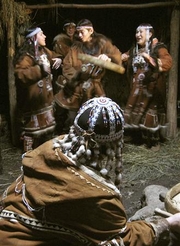After watching the
BBC take on anthropologist - novelist - sorcerer Carlos Castaneda, M. and I rented another documentary about him.
Enigma of a Sorcerer was released in 2002. It is available through
Netflix, but it is only for the hardcore student of neo-shamanism as phenomenon.
Since it is only a collection of interviews (including the late
Dan Noel), someone had the bright idea to put pulsating "psychedelic" backgrounds behind each talking head. "I need Dramamine," M. said, turning away from the screen.
Amy Wallace, one of Castaneda's inner circle of lovers-students in the 1990s and
author of a memoir about that time, was another of the persons interviewed.
Watching both videos, however, you see how Castaneda was somehow possessed by
Dionysus--just like every other death-defying savior with a circle of women: Krishna, Jesus,
Joe Smith, Carl Jung (compare his "
valkyries" to Castaneda's "witches.")
Gurdjieff too, probably.
Soteriology--the various doctrines of salvation--all suggest the story of the God of variousness whose salvific function is well known in the Orphic cult. His name is Dionysus.So writes
David L. Miller (not to be confused with
this David Miller) in
The New Polytheism: Rebirth of the Gods and Goddesses (1974), a book a little ahead of its time.
All promised the overcoming of death. Castaneda, according to the interviews, offered a non-ordinary death--to disappear "bodily into the Second Attention"--to his followers. After he expired from liver cancer in 1998, at least one of his lovers went alone to Death Valley,
where her bones were later found. Three of the "witches,"
Florinda Donner Grau,
Taisha Abelar, and
Carol Tiggs, also killed themselves, Wallace claims. But she offers no details as to when and how--she just thinks that they must have done so.
Actually, had the BBC wanted to do real journalism, they could have found out who cashes the royalty checks from all of Castaneda's books. I assume that they go to
Cleargreen, Inc., the organization that he set up to incorporate his teaching methods.
Castaneda even has his own "Saint Paul,"
Victor Sanchez, who fills the role of the person who never met the Teacher but who claims to be passing on his methods.
Maybe the woman we call Mary Magdalene was either a composite figure or possibly only one of a group of her Dionysian teacher's intimates. There could be a book there . . .
Labels: anthropology, polytheism, Writing
 On the Kamchatka Peninsula in Russia's Far East (across from Alaska), indigenous people are engaged in
On the Kamchatka Peninsula in Russia's Far East (across from Alaska), indigenous people are engaged in 


